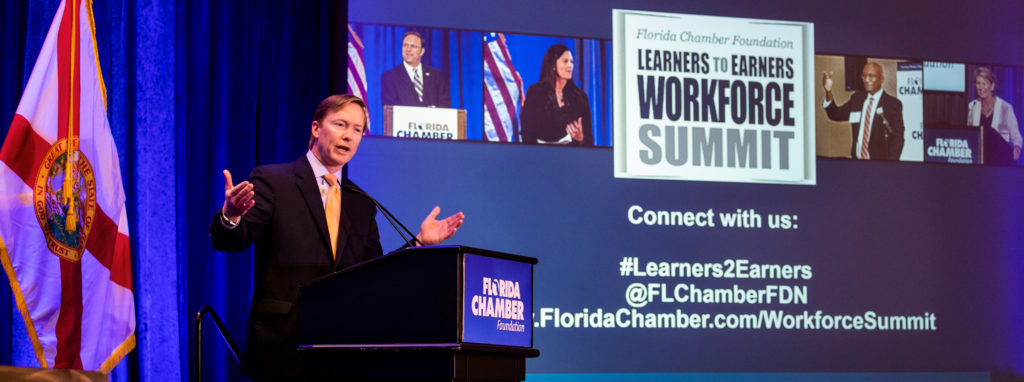Talent is Florida’s Best Economic Currency

Each month, I have the honor of being able to travel across Florida and meet with business leaders who are working hard to create jobs and economic opportunity for Floridians. Across the board, businesses tell me that the biggest issue keeping them up at night is having a talented workforce that will allow them to continue to create jobs and grow in the future. If we look at the jobs in Florida today there are 242,500 open jobs. Said differently, there are 242,500 jobs today looking for people. On the other side we have 391,000 people looking to fill those vacant jobs.
Earlier this month, the Florida Chamber Foundation held their annual Learners to Earners Workforce Summit, where they took a deep dive into how Florida can prepare for the future of work. And these conversations, which centered around building a workforce, are far reaching in scope — we can’t talk about a talented workforce without talking about prosperity, we can’t talk about investments in early learning without talking about Florida’s business climate and, perhaps most importantly, we can’t have any discussions on the challenges and opportunities Florida’s cradle to career continuum faces unless we have them together and work toward one goal.
Commissioner of Agriculture Adam Putnam at the Learners to Earners Workforce Summit
“What are the things we have to do to diversify our economy and truly become the launch pad for the American dream? First, I think we have to recognize that the diversity of our state is a strength,” Commissioner of Agriculture Adam Putnam said. “We need to recognize the successes when they are there. Not enough people know we have the number one state college system in America. There are not enough people who recognize that what they are getting for their families is a world class education.”
When it comes to economic development, talent has already replaced the tax incentive as the number one most important tool in an economic developer’s toolkit. If you don’t believe that, just look at California or Seattle and ask yourself- why would a business add jobs there? Despite their undesirable tax environment and regulatory climate, if that’s where the talent is, talent wins.
Today, if you ask a junior or senior in university or in any of our colleges, they’ll give you a place where they want to live and will bring their skills with them. If Florida can be the best place in the hemisphere in attracting and retaining high-skilled talent, families are going to want to stay here and move here, and businesses would never think of moving anywhere else.
However, in order for Florida to continue to grow we must acknowledge that Florida is changing. Our economics, our demographics and our politics are all changing and these changes are both opportunities and challenges.
What Florida has, is an opportunity to move forward. If we get early learning right, K-12 right, career training right, and lifelong learning right, we won’t have a skills gap in the future. I want to challenge the business community to do a better job communicating to the talent generators what we will need in the future. That might not mean a degree; that may mean a certification or more apprenticeship programs. I want us all to double down on the issue of how important talent is.
To help Florida move in the right direction, it’s vital that we look at what the data shows us. The Florida Chamber Foundation’s first Cornerstone Report in 1989 showed Florida ranked almost dead last in many K-12 metrics- just barely above Mississippi. Fast forward 20 years later and we are now in the top quartile for educational outcomes. We have come a long way with the help of our dedicated partners, a business community that is focused on outcomes and state leadership who is committed to excellence, however, we still have a long way to go. While Florida may be a leader in the United States in education initiatives, the real problem is that the U.S. is rapidly falling in comparison to other countries.
By 2030 Florida will have 5.7 million more people, 3 million new drivers on our roads, 50 million more visitors each year and will need to create at least 1.7 million new jobs over and above what we have right now. There is some great work being done in Florida but at the same time, Florida still has more than 1 million children living in poverty. And while job growth is increasing, Florida will lose more than 1 million jobs due to autonomation.
We Can’t Improve Without the Help of Florida’s Business Community
At the 2018 Learners to Earners Workforce Summit, we released the in-depth recommendations on Talent Supply & Education from our Florida 2030 research. These recommendations show where Florida is, where we need to be and more importantly, how we can work together to get there. I encourage you to take a look and provide your comments and thoughts.
Register today for the annual Future of Florida Forum where we will continue the conversation and release the full Florida 2030 report.
What Others Are Saying
The Tampa Bay Time’s Graham Brink wrote: Florida is in a must-win fight for talented workers. See the Florida Trend’s article about strategic thinking about Florida’s future. Check out the Tampa Bay Business Journal’s: Early childhood learning dominates Tampa business summit.
Thank you to the Florida Chamber Foundation Board of Trustees, for your 50 years of providing leadership in Florida, and to the many partners and businesses who continue to make sure that the right things happen in Florida.
